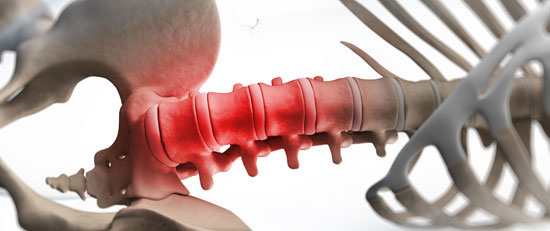Help for 4 Types of Lower Back Pain

Sherwin Nicholson | Updated May 6, 2020
Do you know the 4 types? The more you know, the easier your treatment will be.
Most involve muscular imbalances that either worsen them or are from them. Below you will find a brief explanation of 4 of the most likely types.
1) Vertebral Disc Pain (lumbar)
This happens because of a severe chronic imbalance of the weight distributed on the lumbar discs. An imbalance causes the discs to unnecessarily exert pressure on nearby nerve roots and the spinal cord.
Pressure, when excessive, can trigger a spasm, muscle guarding or can even result in numbness to the area that the nerve supplies sensations.
Disc bulge, herniation and rupture are the worst elements as the symptoms can become immediate and intense. Immobilization is an automatic reaction from your body and triggers back spasms necessary to prevent further injury.
A lot of time is required to recover from a rupture. It can take weeks to months for a full rupture to heal itself to the point of a person being able to return to their previous lifestyle.
2) Vertebral Disc Compression/Degeneration (shrinking)
The second type is when the discs have aged causing disc compression or shrinking. This degenerative process is very common and affects most of the population. It is accelerated with activity and strain. Repeated disc herniations (ruptures) can speed up this process causing the discs of your lumbar spine to become the most likely affected.
Whenever there is degeneration, the disc height is reduced. This causes significant problems in between the vertebrae.
Nerve root compression is likely because the space in between each vertebra reduces as you age. This condition is also known as degenerative disc disease. It usually affects the L1 to L5-S1 lumbar discs. It is very common for the L5-S1 (the lowest of the five) to wear the most.
When the disc loses height, your facet joints bear more pressure and wear. Even though decompression is diagnosed as a disease, it is not as scary as you think. It’s just part of aging.
3) Facet Joint wear, inflammation & pain
This type occurs when your facet joints along your spine become progressively worn from increased pressure and wear.
As the lumbar discs degenerate, the weight they usually absorb is transferred more to each facet joint. Arching your lower spine can be harmful and can trigger a spasm or worse yet a joint fracture.
It’s very common to experience a dull, aching sensation, especially during extended periods of standing.
Having facet joint inflammation means that you should avoid over arching your lower back. This can be very irritating to the articular joint and can be very painful.
Maintaining healthy and fit abdominal muscles is key to minimizing your discomfort.
4) The Intraspinal Muscles
Another common source of discomfort is fatigue from the deeper muscles of the spine. These stabilizing, intraspinal muscles become weaker and more prone to wear and injury.
When the larger muscles supporting your spine lose tone and conditioning, the stabilizers function poorly. The result is very intense spasms.
These problems are brought on by a muscular imbalance. They become more intense or frequent as we age. You can suffer any combination of these as early as during your teenage years. A lifestyle that does not include a healthy way to protect the spine will accelerate this process.
Most of the population will experience at least one of these. Some are unfortunate enough to suffer all of them with frequent episodes.
Don’t Allow these 4 Issues to Remain Just a Part of Your Life
What is important to understand is that lower back problems are not something that should be accepted as simply another part of life as we age. It is also is not something to be ignored either.
A common way to ignore it is to treat it routinely with minimal rest and through the overuse of medications. As vital as rest and medication can be, it is also important to correct any muscular imbalances present.
This way you help to relieve the above types of pain. Correcting muscular imbalances means to learn techniques and exercises that will protect your spine.
Correction does not mean to hit the gym as most of the time this will fail. We are not all athletic in nature nor do we need to be.
Those of us who are already suffering may avoid such advice as it does not make sense to do anything that may exacerbate the problem. Concerns about exercise for relief are valid.
Help
We can correct the imbalances gradually to minimize the chances of injuring or re-injuring ourselves. A small series of corrections are what is preferable. Successful treatment should target the lower back, hips, and legs. It should help to retrain muscles to move effectively.
You cannot treat lower back with just a few simple exercises. If it were this easy, it would not affect so many millions of us every day.
Please take the time necessary to read through the information on this site. It is for those who are experiencing chronic pain. Many tips and suggestions are available.
There are some very helpful home exercises that will help, available to try. If you like the exercises, a more thorough and comprehensive guide is also available.
For more help:
Are your discs ‘degenerating?’
Is your pain acute or chronic?
What you should ask yourself about your pain
References:
- BP – The Facts – John Lee, Clare Daniel, Suzanne Brook. NY. Oxford University Press – 2009. 617.564Lee
- Framework for the Lower Back – Nicholas DiNubile, MD. 2009. Rodale Books Inc. 617.564
- General information-Fact Sheet-NIH-http://www.ninds.nih.gov/disorders/bp/detail.htm
- www.back.com
